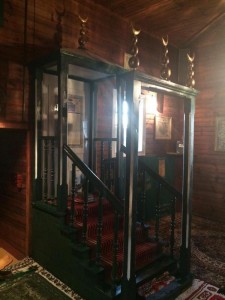
The Tatar Muslim turns to me and laughingly says that on the annual pilgrimage to Mecca, Muslims from other countries like Indonesia looked puzzled when they queried where he was from and the response left them with a look of disbelief. Poland he replied, to which the answer was always the same. ‘Poland? Are there Muslims in Poland?’
It seemed to me that this summed up the position of one of the most incredible, resilient and integrated communities in Europe. The Tatars of Poland are a success story in integration, yet their history is one which is neither acknowledged nor celebrated for what it is, beyond the borders of Poland. It is a story of human survival, patriotism, a desire to belong and in many cases, the ultimate sacrifice on the battlefield for God (Allah), King, Country and Poland.
The interview with the Tatars of Poland in the North Eastern Polish village of Kruzyniany started off with a brief ice-breaker. As the Tatar community representative sat next to me, I mentioned that I brought salaams (greetings) from his cousins from India. The line of Tamerlane, I mentioned, meant that we were distant cousins and that the Tartars were the distant cousins of the Mughals of India. Descendants separated by geography, time and experience, but genetic cousins nonetheless. The response back was even more heart-warming as they acknowledged the link and smiled. Some of the Tatars the community representative said, are called Tomasz; he then smiled and went onto say that their original name was Tamerlane which over time had been adapted to Tomasz.
The first historical mention of the Tatars took place at the end of the 14th century and they were officially recognised in 1410 at the Battle of Grunwald between Poles and Teutonic Knights from Palestine who had been invited by the Polish Duke of Mazowsze, Konrad Mazowiecki, some 200 years before in order to fight against pagan Prussians. In 1410, at the Battle of Grunwald, the first military reference to Tatar Muslims were made as they fought for the independence of the country against the occupation of the Teutonic knights who had by now, expanded their control over Polish lands.
What is also interesting to note is that at the Battle of Vienna, which took place on September 12th, 1683, Tatar Muslims allied to Polish forces who defended the City as they stood against their fellow co-religionists from the Turkish Ottoman Empire. This important fact is conveniently left out by Islamophobes who choose to talk about the Battle of Vienna in terms that promote ‘a clash of faiths’ and who think of the Battle of Vienna in terms of Christians fighting Muslims. The real fact is that Tatar Muslims fought with and for King Jan III Sobieski of Poland, a myth now busted as I sat in the wooden cabin in Kruzyniany.
1683, Tatar Muslims allied to Polish forces who defended the City as they stood against their fellow co-religionists from the Turkish Ottoman Empire. This important fact is conveniently left out by Islamophobes who choose to talk about the Battle of Vienna in terms that promote ‘a clash of faiths’ and who think of the Battle of Vienna in terms of Christians fighting Muslims. The real fact is that Tatar Muslims fought with and for King Jan III Sobieski of Poland, a myth now busted as I sat in the wooden cabin in Kruzyniany.
In fact, it was because of the support that Tatar Muslims gave to King Sobiesksi that led to an agreement which shaped the lives of Tatars in Poland for the foreseeable future. The King realised the military importance of the Tatars and acknowledged their support at the Battle for Vienna. In return, they were gifted with land in the village of Kruzyniany and with the right to worship and the opportunity to marry Polish women. In return, the King regarded the Tatars as his special crack troops and could now be able to muster them when needed in the defence of the Polish realm. Therefore, as I sat in Kruzyniany listening to the Tatar Muslims of Poland, I was sitting in an area of land given to the Tatars in their defence of Vienna against their co-religionists from the Ottoman Empire.
Military Careers
The over-representation of generals from the Tatar Muslim community within the Polish military was well recognised given the fervour and patriotism of the Polish Tatars and given their loyalty to the State. Tatars acted as bodyguards for leaders of the State and given that the Polish army was so much a part of their lives, a Tatar Imamat or chaplaincy service to provide pastoral care for Muslim soldiers was set up, so as to ensure that the spiritual needs of soldiers were met. The State had clearly recognised the importance of these units and to ensure that they were able to focus on the military tasks at hand, an investment to support their pastoral care was made.
Interestingly, in the 2nd World War, a unit of soldiers from Vilnius (Lithuania) was made up of Tatars who saw action and the War also saw Tatar involvement in the horse units that so bravely charged around and against German Panzers as they invaded Poland in a Blitzkrieg In 1939. Many of them simply had no chance of survival, yet they faced the odds and with sword and lance in hand, they stood bravely against the German war machine.
Monuments of History and Numbers of Tatars
 There are 56 ‘Monuments of History’ in Poland which provide a national protected status to historical, cultural and religious monuments in the country. The two Tatar Muslim mosques in Kruzyniani and Bohiniki have protected status as Monuments in History.
There are 56 ‘Monuments of History’ in Poland which provide a national protected status to historical, cultural and religious monuments in the country. The two Tatar Muslim mosques in Kruzyniani and Bohiniki have protected status as Monuments in History.
These titles were provided to the mosques in 2012 by the President of Poland showing how important the leadership of the country sees its Tatar heritage. After the loss of nearly 3 million Jews due to the Final Solution implemented by the Nazis, the loss of heritage and cultural diversity in Poland has meant that it has actively tried to protect the remnants of diverse communities in the country. This is to be lauded and valued, given that Poland is still trying to recover after decades of foreign powers controlling the country. Furthermore, moves are afoot to try and register the two mosques in Kruzyniani and Bohiniki as UNESCO World Heritage sites and this work is ongoing.
Lithuania currently has about 4,000 Tatar Muslims with 6,000 resident in Belorussia and between 2,500 to 3,000 in Poland. Many Tatars, like Poles were deeply affected by the Nazi occupation. The murder of approximately 3 million Jews and the work camps that saw the death of non-Jewish Poles and Tatars meant that every segment of the country was affected. Tatar communities ended up in work camps which literally worked them to death and the country, its history and heritage was simply trampled on by the marauding German war machine. Yet, 70 years later and after Soviet occupation and interference, Poland is starting to grow into the nation that it wants to be.
The Resilience of the Tatars
 It is interesting to note that one of the first organised Muslim communities in the United States was a small Tatar community that emigrated from Poland in 1890. This small Tatar community built their mosques and maintained their heritage once again in the New World and with overwhelming odds stacked against them. A look at their first constitution which was lodged to register the organisation with the State of New York shows a list of names that are clearly Turkic and Polish in their origin, yet a picture of the first founding members also shows the Turkic genetic influences that are so evident in the Tatar community to this date.
It is interesting to note that one of the first organised Muslim communities in the United States was a small Tatar community that emigrated from Poland in 1890. This small Tatar community built their mosques and maintained their heritage once again in the New World and with overwhelming odds stacked against them. A look at their first constitution which was lodged to register the organisation with the State of New York shows a list of names that are clearly Turkic and Polish in their origin, yet a picture of the first founding members also shows the Turkic genetic influences that are so evident in the Tatar community to this date.
Descendants of this first Tatar Muslim community can still be located in New York and re-enforce one of the most important elements of the Tatars – their desire to maintain their community, yet their willingness and flexibility to integrate into countries where they find themselves. This was the overwhelming perspective that was evident when I sat with the Tatars of Poland. If anything, they are an example to other communities about people can maintain their sense of identity whilst being a part of the fabric of the adopted country. Could they then possibly be called the Muslim Jews of Europe?
Whilst this may be somewhat simplistic, it certainly has a ring and truth to it on the basis of shared histories and a desire to survive against overwhelming odds. Poland, the Polish people and the Tatars are an inspiration who need support. At the very least, a visit to this country can enrich the soul and open the mind and help to counter some of the bigotry and ignorance that is targeted to this wonderful country and its welcoming people.
This interview was conducted by the Director of Faith Matters, Fiyaz Mughal OBE. Faith Matters would like to thank the Ministry of Foreign Affairs of Poland in supporting this visit, Sebastian Rejak, Filip Slipazeck, Konrad Adamowicz, Andrzej Saramowicz and the wonderful people of Poland. Further articles on the Tatars of Poland will appear on Religious Reader, a web-site focusing on faith communities in the UK and which will be launched by Faith Matters in December 2014.